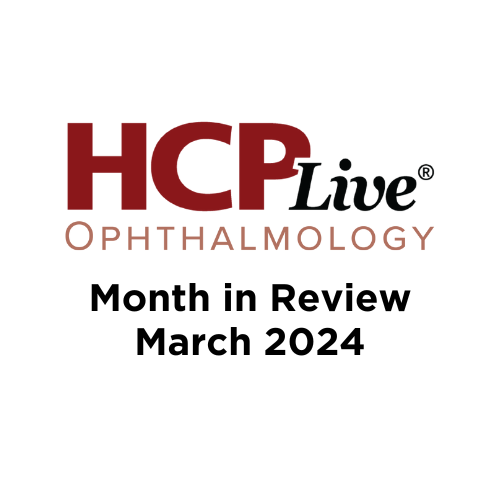Ophthalmology Month in Review: March 2024
Each month, our editorial staff compiles a recap of the top news in ophthalmology. Our March 2024 ophthalmology month in review features a recap of the latest news from the ophthalmic pipeline.
Credit: HCPLive

Wrapping up the first quarter of 2024, March pushed ahead with full steam and shook off any cobwebs remaining from the beginning of the year. Across medicine, it seemed like topline data and US Food and Drug Administration (FDA) approvals were being announced every day and ophthalmology was no different.
Continuing last year’s trend, our ophthalmology month in review for March 2024 centers around the burgeoning ophthalmic pipeline.
These pipeline updates included the first US Food and Drug Administration (FDA)-approved steroid in over 15 years on the ophthalmic market, a novel eye drop that lowers intraocular pressure (IOP) better than standard of care in glaucoma, and positive data for a potential one-time gene therapy for the treatment of neovascular (wet) age-related macular degeneration (nAMD).
Pipeline News
FDA Approves Clobetasol Propionate Eye Drop for Post-Ocular Surgery Pain
On March 4, 2024, the FDA approved clobetasol propionate ophthalmic suspension 0.05% (APP13007) for treating post-operative inflammation and pain following ocular surgery. Across two phase 3 clinical trials, the ophthalmic suspension demonstrated rapid and sustained reduction of inflammation that was statistically and clinically superior versus placebo (P <.001).
The formulation is the first FDA-approved ophthalmic clobetasol propionate product and the first new steroid in over 15 years on the ophthalmic market. Awarded to a collaborative team of Formosa Pharmaceuticals and AimMax Therapeutics, Eyenovia is anticipated to lead the ophthalmic suspension commercialization in the US.
Nesvategrast for Diabetic Retinopathy Misses Primary Endpoint in Phase 2 Trial
Topline results from the phase 2 DR:EAM trial investigating nesvategrast (OTT166), a novel eye drop for diabetic retinopathy, showed the drug did not achieve its primary or key secondary efficacy endpoints, despite the treatment’s positive safety and tolerability.
As announced by OcuTerra on March 14, 2024, nesvategrast failed to demonstrate a statistically significant improvement on the diabetic retinopathy severity scale (DRSS) versus placebo, over 24 weeks of treatment. The company noted its disappointment in the lack of a statistically significant effect in the phase 2 trial but plans to evaluate strategic alternatives moving forward.
NCX 470 Lowers Intraocular Pressure More Than Standard of Care in Glaucoma
Data from the pivotal phase 3 Mont Blanc trial revealed the nitric oxide-donating prostaglandin analog, NCX 470 0.1%, lower intraocular pressure (IOP) more than latanoprost, the standard of care, in the treatment of open-angle glaucoma and ocular hypertension.
“With a dual mechanism of action that enhances both uveoscleral and trabecular outflow, NCX 470 could become an important first-line therapy for IOP reduction in glaucoma,” wrote the investigative team, led by Robert Fechtner, MD, professor and chair of the department of ophthalmology, SUNY Upstate Medical University.
Metformin May Prevent Geographic Atrophy Onset, Independent of Diabetes Status
A common anti-diabetic drug, metformin, demonstrated promise as an alterantive agent in the development of geographic atrophy (GA), a late-stage form of age-related macular degeneration (AMD).
The case-control study used the Merative MarketScan Commercial and Medicare databases to identify new-onset International Classification of Diseases (ICD) coding of GA, to assess the association between metformin and AMD development. Multivariable regression analysis, adjusted for AMD and other anti-diabetic medications, revealed metformin reduced the likelihood of new-onset coding of GA by 12%.
“Given the findings from this study, metformin’s ease of use, and the shortcomings of current therapeutics for GA, metformin may hold promise as an alternative agent that can be repurposed for preventing GA,” wrote Dimitra Skondra, MD, PhD, department of ophthalmology and visual science, University of Chicago and colleagues.
RGX-314 Gene Therapy for nAMD Well-Tolerated in Phase 1/2a Study
Subretinal delivery of ABBV-RGX-314 gene therapy was well-tolerated with no clinically recognized immune response in the treatment of neovascular (wet) age-related macular degeneration (nAMD). Over two years, these phase 1/2a results demonstrated the novel approach may provide sustained vascular endothlieal growth factor (VEGF)-A suppression, with potential to maintain vision and reduce treatment burden after a single dose.
“A single treatment of ABBV-RGX-314 that can potentially provide long-lasting treatment outcomes and a strong safety profile would offer a novel approach to treating this serious and blinding disease,” Jeffrey S. Heier, MD, director of the vitreoretinal service and retina research, Ophthalmic Consultants of Boston, and primary study investigator, said in a statement.
Aflibercept 8 mg Exhibits Non-Inferior Vision Gains in PULSAR, PHOTON Trials
One-year results from the pivotal, phase 3 PULSAR and PHOTON trials demonstrated the noninferiority of aflibercept 8 mg (EYLEA HD) to aflibercept 2 mg (EYLEA) in the treatment of wet AMD and diabetic macular edema (DME). Extended 12- or 16-week dosing regimens of aflibercept 8 mg showed non-inferior vision gains to standard-of-care aflibercept 2 mg with fixed 8-week dosing in the first year of treatment.
“Aflibercept 8 mg is a vital tool in our toolkit, it represents another durable agent that we can turn to as retina specialists and ophthalmologists in treating a retinal vascular disease,” Deepak Sambhara, MD, medical director of research and partner at Eye Clinic of Wisconsin told HCPLive. “When I saw the [PULSAR and PHOTON] trial data, my question was, ‘How is this going to translate to my practice?’ and what I found from being an early adopter is I’m able to get a subset of my population out further than ever before on aflibercept 2 mg.”